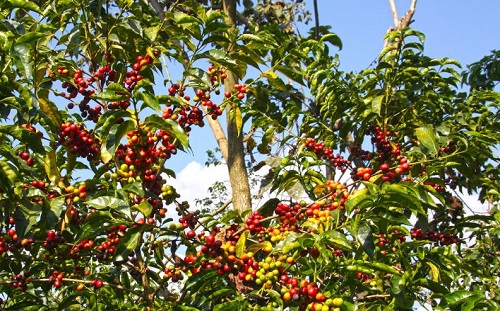
Ethiopia is known for being the birth place of coffee. On top of that coffee is the country’s most important export crop, accounting for 28.7 percent of the country’s commodity exports in 2018/19 (NBE, 2019). It is estimated that its highly valued Arabica coffee is cultivated by over 6 million smallholders in the country and employs about 15 million people across the value chain (CSA, 2020; FSA/USDA, 2018).
Moreover, coffee income has been shown to lead to improved food security in the country (Kuma et al., 2019). While coffee production and exports have increased over the last decade (Minten et al., 2019), there are a number of constraints still holding the sector back from attaining its full potential.
Though the country is well known for coffee production, it lacks behind other countries in the volume of its productivity. In 2019, official coffee yields estimate in Ethiopia were on average 61 percent below that of Brazil (the world’s number one coffee producer) and 29 percent below the world’s average yield (FAOSTAT, 2021). According to a report from World Bank (WB) the problem boils down to a lack of pruning. Almost 80 per cent of Ethiopia’s 1 million hectares of coffee trees are underproductive because the trees are not trimmed often enough.
Low-yielding aged coffee trees and poor farm management and agronomic practices are among the main constraints. Most coffee trees currently grown in Ethiopia were planted over two-three decades ago, and farmers have rarely been taught on how to rejuvenate their coffee trees to sustainably improve their yields (Minten et al., 2019; Amamo, 2014; Woldetsadik and Kebede, 2000).
Stumping or rejuvenation of coffee trees is found to be a good method to enhance the productivity of coffee. A study conducted in 2015 indicates that In four, five and seven year’s cycle stumping trials, stumped plots gave higher yields than unstumped coffee. Similarly, it was observed that yield of old coffee stands increased by 43.2, 40.4 and 38.0, and 12.6, 8.4 and 4.7% using rejuvenation methods, namely topping, agobiado and eskeletamento, as compared to the conventional clean stumping and the control (not rejuvenated) plot, respectively (Figure 10).
However, the adoption of the different rejuvenation methods may be influenced by stem nature of coffee trees (flexible or stiff), spacing between plant (population density), age of coffee trees, economic status of the farm and management system (Yacob et al., 1996; Anteneh, 20015). Thus, these factors determine the economic feasible method to be adopted to renew old coffee orchards.
A study by International Food Policy Research Institute (IFPRI) shows that the low productivity of Ethiopia’s coffee trees poses an obvious problem for the more than 2 million smallholder farmers dependent on coffee production for their livelihoods. This issue has also created a problem for Ethiopia’s forests. The expansion of coffee plantations driven by low productivity is degrading forest land and increasing emissions from the forest sector.
The study evaluated the short-term (immediate) impact of the Coffee Farm College’s first rejuvenation training on adoption rate and intensity of stumping in Sidama zone, Ethiopia. The rejuvenation training aims at revitalizing low-yielding aged coffee trees, which is a main constraint in Ethiopia for coffee trees in attaining its full yield potential. This particular training mainly promotes stumping, a practice that entails properly cutting of old and unproductive coffee trees at its base for a complete renewal which will result in an increase in the quantity and quality of coffee harvests after a two-year period.
The unique feature of the Coffee Farm College agronomy program is that it is held in small groups at focal farmer (development) group level to facilitate and ensure active participation of smallholder coffee farmers. Moreover, training sessions are held at demonstration plot that are owned by a member of the local farmer group to facilitate learning-by-doing and to serve as a demo plot where farmers can see first-hand the results of properly implemented best agronomic and farm management practices on the health of the coffee plants and its productivity.
Using detailed household and plot (field) level data collected before and after the first rejuvenation training and a difference-in-difference estimation approach, we find that participation in the rejuvenation training had a positive and statistically significant effect on both adoption rate and intensity of stumping. Specifically, we find that the training increased the adoption rate and intensity of stumping by 19 and 3 percentage points, respectively. Given the low adoption rates of stumping at baseline, these impacts represent close to a threefold increase in the rates and intensity of adoption after the training intervention.
The study also explored possible impact heterogeneity by key plot and household characteristics through sub-sample analysis and find that the magnitude of the training impact on adoption rate and intensity of stumping significantly increases with farm size, number of coffee trees, and access to a stumping saw. Overall, the results provide robust evidence that participation in the rejuvenation training has led to a significant increase in the adoption rate and intensity of stumping. This finding has important practical and policy implications given that most coffee trees in Ethiopia are reportedly old and rejuvenating ageing and unproductive coffee trees markedly improve the plant health and its productivity sustainably.
BY STAFF REPORTER
The Ethiopian Herald May 26/2021




